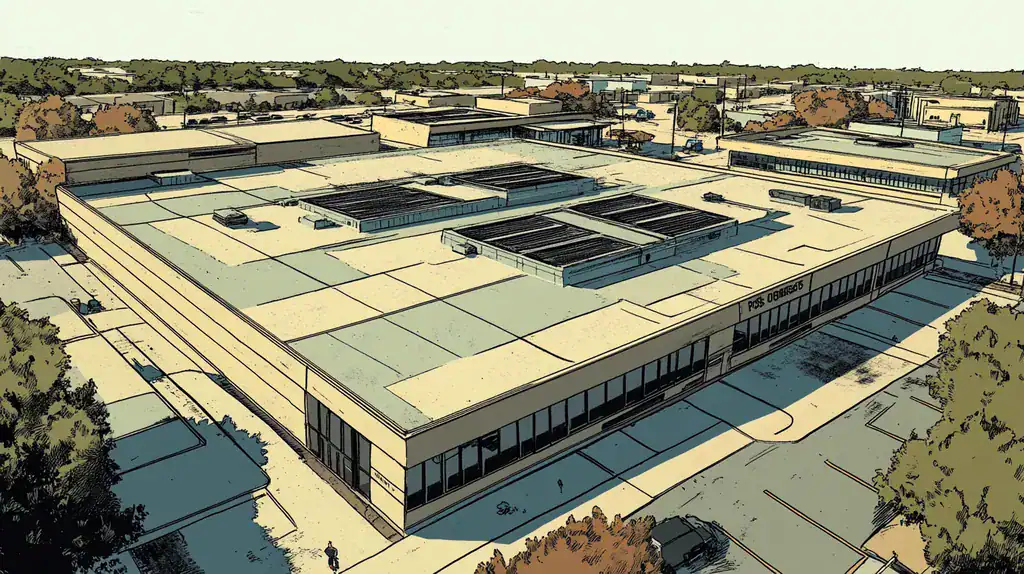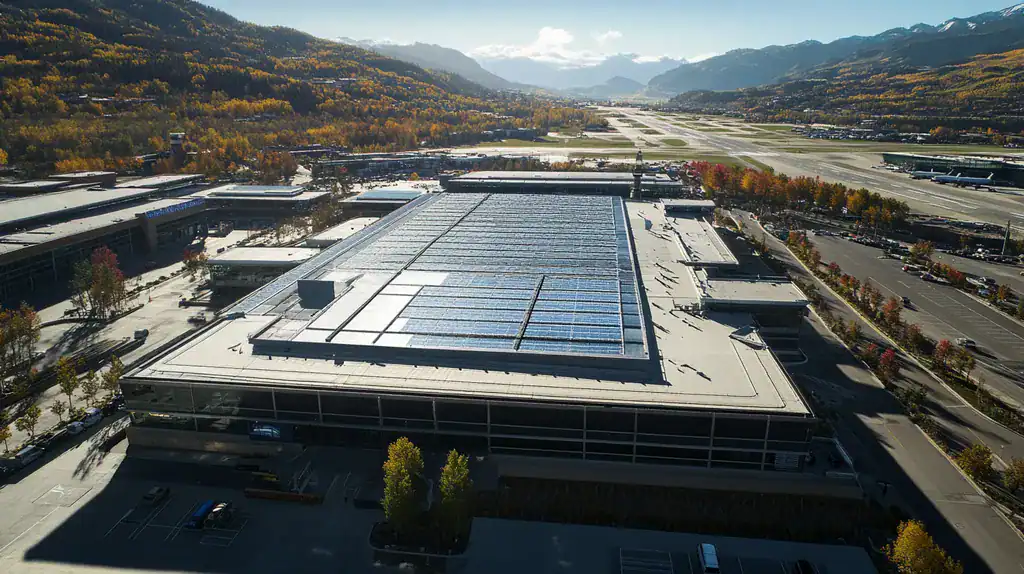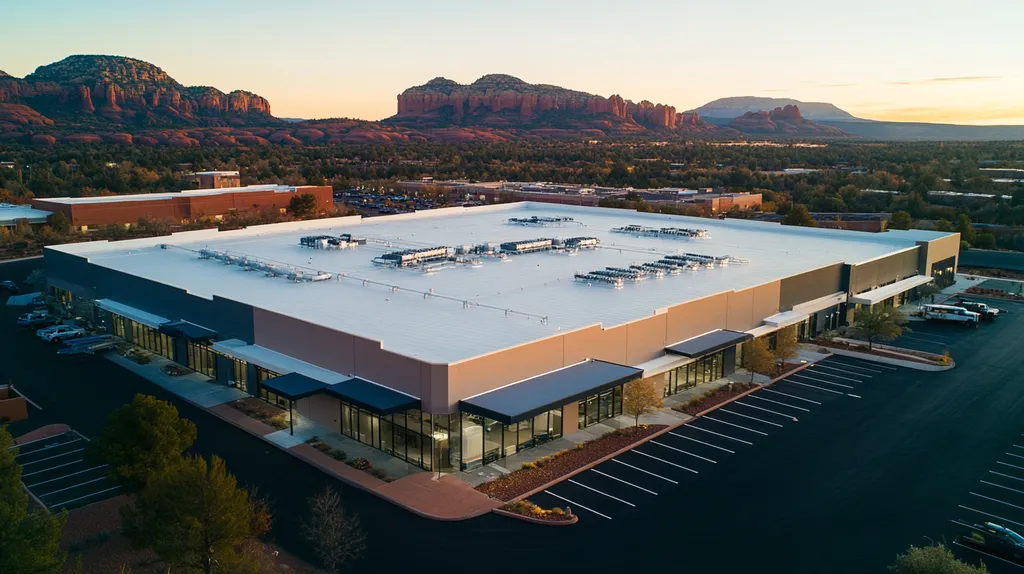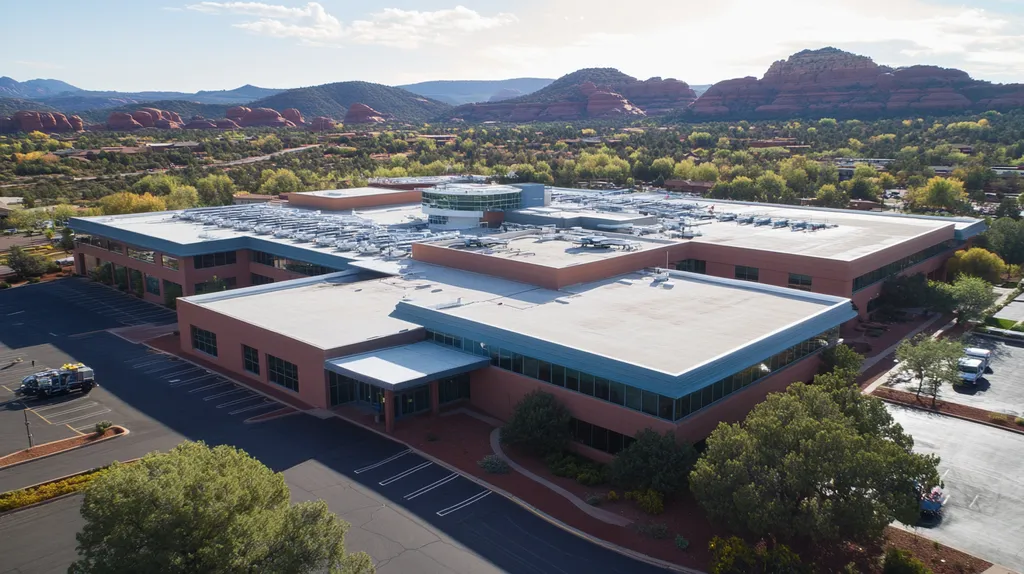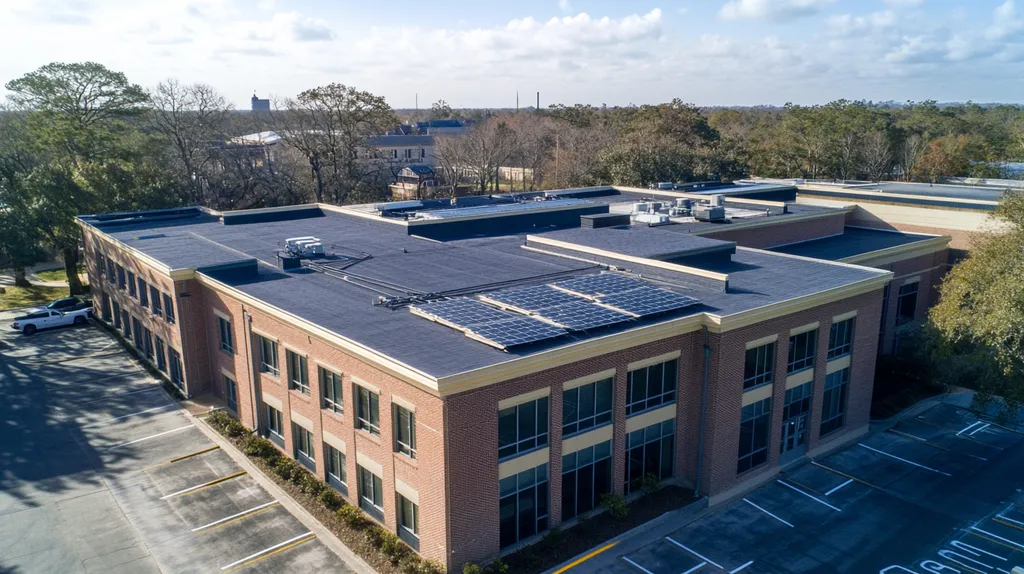Roof penetrations account for over 45% of all commercial roofing failures, resulting in billions in annual repair costs across North America. These critical weak points, from HVAC installations to plumbing vents, require careful management to prevent catastrophic leaks and structural damage.
For facility managers, understanding proper penetration installation, maintenance, and repair is essential for protecting their building investments. Even a single compromised roof penetration can lead to extensive water damage, with repair costs often exceeding $100,000 per incident.
This comprehensive guide provides facility managers with actionable solutions for managing roof penetrations through six key areas: performance factors, financial considerations, compliance requirements, risk management, operational procedures, and long-term planning strategies.
SECTION 1: PERFORMANCE FACTORS
Penetrations in commercial roofing are not just minor concerns; they can lead to major issues if neglected. According to a survey by the National Roofing Contractors Association, a staggering 45% of roofing leaks come from these vulnerable points. For facility managers, understanding the types of roof penetrations and evaluating their conditions is vital to prevent costly repairs and enhance the longevity of the roofing system. This section outlines the common types of penetrations, highlights the importance of seal integrity, and emphasizes material compatibility to maintain a leak-free roof.
Identifying Common Types of Roof Penetrations
Common roof penetrations arise from sources such as HVAC units, plumbing stacks, ventilation systems, and skylights. Each of these components introduces weak points that can compromise the roofing system’s integrity. For example, ductwork needs adequate sealing to avoid air leaks, which can negatively affect energy efficiency.
If seals around these penetrations are insufficient, serious water infiltration can occur, leading to structural damage. Regular inspections for water stains or pooling are crucial for early detection. Identifying these penetration types can significantly improve maintenance practices and prevent severe issues later.
Another aspect to consider is the quality of the original installation. Improperly executed installations can lead to premature failures. By reviewing installation documentation, facility managers can uncover potential weaknesses in how penetrations were created.
Key Action Items
Assessing Seal Integrity and Leak Potential
The integrity of seals is a key performance factor when managing roof penetrations. Over time, factors like UV exposure and temperature shifts can wear down sealants, significantly raising the likelihood of leaks.
Routine inspections should focus on the condition of all sealants and flashing materials. Facility managers must look for signs such as cracks, peeling, and seam separation, as these can indicate imminent failure. Identifying these issues early is critical for avoiding more severe consequences.
The repercussions of leaks extend beyond immediate repairs; they can foster mold growth, create safety hazards, and lead to expensive damage. Therefore, assessing seal integrity must be a regular part of roof maintenance strategies.
Key Action Items
Evaluating Material Compatibility and Durability
The performance of roof penetrations significantly hinges on material compatibility. Using mismatched materials can lead to accelerated deterioration and unexpected issues. For example, inappropriate sealants on metal roofs can result in increased corrosion.
Facility managers must familiarize themselves with the materials specified for their roofing systems and associated penetrations. Regular compatibility assessments are essential to avoid failures and enhance the roof’s lifespan.
Durability should also be a primary concern. Utilizing high-quality materials that can withstand environmental stresses will improve the longevity of penetrations. Investing in durable systems can prevent frequent repairs, ultimately saving costs.
Key Action Items
SECTION 2: FINANCIAL CONSIDERATIONS
The financial stakes surrounding penetrations in commercial roofing are significant. Neglected leaks from these areas can cause severe water damage, often resulting in repair costs that soar above $100,000 per instance. For facility managers, this makes it crucial to conduct thorough cost analyses, allocate budgets for proactive maintenance, and recognize the long-term financial impacts of penetration-related failures.
Cost Analysis of Penetration Installation and Repair
A thorough cost analysis for installing and repairing roof penetrations is essential for budget management. Costs for new penetrations can vary between $500 and $2,000, influenced by their type and complexity. Proper installation today can save significant expenses down the road, including repairs and operational downtime.
It’s vital for facility managers to consider not only initial expenses but also the lifecycle costs tied to penetrations, such as ongoing maintenance and future upgrades. A failure to conduct a detailed analysis can lead to unanticipated financial challenges.
Regular assessments of existing penetrations can help spot potential issues before they escalate. Engaging with qualified roofing contractors for precise estimates ensures that budgetary allocations are accurate. By prioritizing installation quality and comprehensive analysis, facilities can protect their financial well-being.
Key Action Items
Budgeting for Preventive Maintenance and Inspections
Developing a solid budgeting strategy for preventive maintenance and inspections is critical for safeguarding roofs. Many facility managers typically allocate just 1% of their property’s replacement value for maintenance, but experts suggest 2% or more—especially for commercial roofs with numerous penetrations. Skimping on this budget can turn small problems into major, costly repairs.
Routine inspections should be integral to every preventive maintenance plan, allowing potential failures to be caught early. Utilizing modern inspection techniques, such as thermal imaging or drones, further enhances monitoring efforts.
By ensuring adequate budget provisions for maintenance, businesses can significantly reduce the financial risks associated with penetration damages. A proactive approach not only saves money but also extends the overall lifespan of the roofing system.
Key Action Items
Long-term Cost Implications of Penetration Failures
Failure to address penetration issues can lead to staggering long-term costs. Beyond immediate repair expenses, water intrusion may cause severe mold problems, which could cost tens of thousands to remediate. Additionally, businesses can experience losses due to operational downtime.
For example, if penetrations fail and allow water to enter, not only can the roof be compromised, but it could also damage valuable inventory and interior spaces. Taking preventive measures is essential for maintaining financial stability.
It’s also important to note that insurance may not cover all costs from penetration failures, often leaving facility managers with unexpected out-of-pocket expenses. Understanding and preparing for these potential long-term financial impacts is vital to protect investments.
Key Action Items
SECTION 3: COMPLIANCE REQUIREMENTS
Addressing roof penetrations is essential for compliance and safety. Failing to meet building codes and roofing standards can lead to significant legal and financial troubles, including leaks and structural failures. Facility managers must ensure compliance through proper flashing techniques and diligent documentation practices to protect building integrity and mitigate risks.
Understanding Building Codes and Roofing Standards
Building codes are the backbone of safety regulations for commercial roofs. These codes, which vary by location, detail requirements relating to materials, structural integrity, and weatherproofing. Facility managers must keep updated on local codes to ensure compliance for all roofing work.
Equally important are the roofing standards set by organizations like the American Society for Testing and Materials (ASTM). These standards ensure that roofing materials are reliable and perform well. Non-compliance can lead to warranty voids and diminished roof performance.
Consulting with roofing professionals can help navigate these rules effectively. It’s critical that all penetrations, whether for HVAC, plumbing, or electrical systems, adhere to these regulations to minimize potential liabilities.
Key Action Items
Ensuring Proper Flashing and Weatherproofing Practices
Flashing is vital for preventing water intrusion at roof penetrations. Properly installed flashing creates a reliable seal that protects against leaks. Inadequate flashing can result in costly repairs and equipment failures.
Weatherproofing is equally crucial; it involves using materials that can withstand the specific climate challenges of the building location. Facility managers should ensure that contractors use tested and approved solutions for every project.
Routine maintenance checks are necessary to identify any signs of wear or damage in flashing and weatherproofing. Scheduling seasonal evaluations helps ensure that these critical areas remain intact and effective.
Key Action Items
Documentation and Inspection Protocols for Compliance
Maintaining thorough documentation is essential for compliance with roofing standards. Keeping detailed records of installation practices, materials, and inspections can provide valuable support during disputes or if issues arise.
Establishing a structured inspection protocol is equally important. Regular inspections offer a clear assurance that safety regulations are being followed. Facility managers should schedule inspections during different stages of roofing projects.
Utilizing detailed checklists during these inspections can help ensure thoroughness. Items should include evaluating flashing, sealant integrity, and the condition of all penetrations.
Key Action Items
SECTION 4: RISK MANAGEMENT
Roof penetrations introduce significant vulnerabilities that can lead to costly damages if ignored. Research indicates that approximately 20% of commercial roofing failures originate from these critical areas. For facility managers, recognizing and addressing these risks is essential to safeguard investments and maintain seamless operations.
Diagnosing Vulnerabilities in Roof Penetration Areas
Identifying the locations of roof penetrations is crucial in managing risk effectively. Common areas such as HVAC units, skylights, and vent pipes can permit water intrusion if seals are compromised. Conducting thorough inspections helps uncover visible and hidden vulnerabilities, especially around flashing and sealants.
Signs of trouble, like excessive water pooling or poor drainage near penetrations, can signal potential issues. Managers should also check for evidence of previous repairs, which may suggest ongoing leakage problems. Regular assessments can keep potential failures at bay.
Employing thermal imaging or moisture mapping technology can enhance diagnostic efforts by revealing hidden concerns early on. Although these technologies may require upfront investment, they can save facilities from incurring larger expenses related to significant water damage later.
Key Action Items
Developing a Leak Detection and Response Plan
Crafting a comprehensive leak detection and response plan is critical for minimizing damage from potential penetrations. This strategy should include methods for early leak identification, such as moisture sensors and regular visual inspections. Swift detection can significantly limit damage severity.
Facility managers should equip staff with the knowledge to recognize leak indicators like stains, mold, and unusual odors. Proper training empowers employees to act quickly, potentially avoiding a larger crisis.
The response plan must outline clear steps to take upon leak detection, encompassing immediate reporting and repair procedures. Taking swift action can prevent extensive deterioration and costly repairs.
Updating and testing the leak detection plan regularly is essential. Incorporating new technologies can improve readiness and response times, saving thousands in damage control expenses.
Key Action Items
Implementing Safety Measures During Installation and Repairs
Ensuring safety is paramount when installing or repairing roof penetrations. Hazards such as falls, material handling, and adverse weather can jeopardize the safety of maintenance crews. Establishing robust safety protocols is essential to prevent accidents.
Utilizing safety harnesses and proper scaffolding protects workers during installation and repair tasks at height. Managers must ensure that all team members receive adequate safety training before beginning any roofing work.
Clearly marking and securing areas where penetrations are added or fixed will help prevent accidents. Ensuring all necessary safety equipment is available minimizes risks related to these critical operations.
By prioritizing safety, managers not only safeguard their employees but also foster a culture of compliance. This proactive approach reduces overall liability and enhances the effectiveness of maintenance strategies.
Key Action Items
SECTION 5: OPERATIONAL PROCEDURES
Effectively managing roof penetrations is essential for the longevity and reliability of a commercial roofing system. A recent study highlighted that 60% of commercial roof leaks arise from inadequately sealed penetrations. Facility managers must enact robust operational procedures to ensure these critical zones are properly managed. This section outlines verified steps for installation verification, inspection checklists, and coordination between roofing and HVAC teams.
Step-by-Step Verification of Penetration Installation
Implementing a rigorous installation verification process is the cornerstone of effective penetration management. Each penetration must be inspected meticulously during and after installation to confirm proper sealing. This involves checking the alignment, materials utilized, and adherence to manufacturer specifications.
Special attention should also be given to the flashing around penetrations. Compromised flashing can lead to water infiltration, weakening the roofing system overall. Facility managers must ensure that all sealants are applied correctly and are fully compatible with the roofing materials.
Documenting the entire installation process is vital for accountability. A detailed log aids in tracking issues over time and informs future repairs. This organized approach reduces leak risks significantly and extends the roof’s usable life. Ongoing staff training on installation techniques is also critical for sustaining high-quality standards.
Key Action Items
Routine Inspection Checklists for Facility Managers
Regular inspections are critical for ensuring the integrity of roofing penetrations. Facility managers should adopt a routine inspection checklist concentrating on penetrations. This checklist should encompass the condition of seals, the integrity of flashing, and any visible wear or damage.
Seasonal inspections are particularly urgent. Weather can exacerbate existing vulnerabilities in roofing systems, especially around penetrations. Conducting inspections before severe weather events allows for early identification of critical issues.
Additionally, utilizing drone technology enhances the inspection capability significantly. Drones offer a safe and efficient way to pinpoint problems from above, enabling facility managers to address those issues before they evolve into costly repairs. Ensuring that each inspection is documented provides valuable insights for future maintenance efforts.
Key Action Items
Coordinating Roofing and HVAC/Equipment Teams
Effective coordination between roofing and HVAC equipment teams is crucial for proper penetration management. Miscommunication can result in overlooked issues and unnecessary expenses. To mitigate this, regular meetings must be established to discuss project updates, maintenance schedules, and concerns regarding penetrations.
Facility managers should also outline clear protocols defining responsibilities for the maintenance and inspection of roof penetrations. This clarity ensures all parties understand their duties and when to carry out necessary inspections or repairs.
Sharing access to documentation, like installation logs and inspection reports, promotes better collaboration. By having all relevant information readily available, teams can more effectively work together to mitigate risks and maintain the roofing system’s integrity. Fostering a proactive maintenance culture enhances team alignment, enabling swift issue resolution.
Key Action Items
SECTION 5: OPERATIONAL PROCEDURES
Efficient management of roof penetrations is crucial for the durability and reliability of commercial roofing systems. Research shows that roughly 60% of roof leaks can be traced back to poorly sealed penetrations. It is essential for facility managers to institute stringent operational procedures to effectively address these critical areas. This section outlines comprehensive steps for verifying installations, establishing inspection protocols, and facilitating cooperation between roofing and HVAC teams.
Step-by-Step Verification of Penetration Installation
The foundation of effective penetration management lies in a meticulous installation verification process. Every penetration should be inspected during and after installation to ensure proper sealing. This includes checking alignment, confirming the materials used, and ensuring compliance with manufacturer specifications.
Moreover, assessing the flashing around penetrations is vital. Defective flashing can lead to water infiltration which compromises the roofing system. Facility managers should also confirm that sealants are applied correctly and are compatible with the roofing materials.
Thorough documentation of the installation process fosters accountability. Maintaining a detailed log helps track potential issues over time and guides future repairs. This organized approach reduces leak risks and extends the roof’s lifespan.
Investing in regular staff training on installation best practices is highly recommended to ensure high-quality standards are maintained.
Key Action Items
Routine Inspection Checklists for Facility Managers
Regular inspections are a cornerstone of maintaining the integrity of roofing penetrations. Facility managers should develop a routine inspection checklist that focuses specifically on penetrations. This checklist must address the condition of seals, integrity of flashing, and any visible signs of damage or wear.
Seasonal inspections hold particular importance, as adverse weather can exacerbate vulnerabilities at penetrations. Conducting inspections before severe weather can help identify critical issues in advance.
Additionally, leveraging drone technology can significantly enhance inspection capabilities. Drones allow for safe and efficient identification of issues from above, enabling proactive interventions before minor problems escalate into costly repairs.
Each inspection’s documentation serves as a crucial resource for tracking maintenance history and informing future decisions.
Key Action Items
Coordinating Roofing and HVAC/Equipment Teams
Collaboration between roofing and HVAC equipment teams is essential for effective penetration management. Miscommunication among team members can result in overlooked problems and higher repair costs. Regular meetings should be established to discuss project updates, maintenance schedules, and any penetrating concerns.
Facility managers must create clear protocols that delineate responsibilities for the maintenance and inspection of roof penetrations. Clarity in roles ensures that everyone understands when to conduct inspections or initiate repairs.
Sharing access to documentation, such as installation logs and inspection reports, promotes better teamwork. Having all necessary information available helps teams collaborate effectively to mitigate risks.
Fostering a proactive maintenance culture enhances coordination, allowing teams to address issues swiftly before they develop into major problems, thereby maintaining the roofing system’s integrity.
Key Action Items
The Bottom Line
With roof penetrations accounting for nearly half of all commercial roofing failures and billions in annual repair costs, facility managers cannot afford to overlook these critical vulnerabilities.
Proper penetration management requires a comprehensive approach spanning performance monitoring, financial planning, compliance, risk management, and clear operational procedures.
The stakes are significant: a single compromised penetration can result in repair costs exceeding $100,000, not including potential business disruption and inventory losses.
By implementing the strategies and checklists outlined in this guide, facility managers can effectively protect their roofing investments while ensuring regulatory compliance and minimizing costly emergency repairs.
The future of commercial roofing depends on treating penetrations not as mere necessities, but as critical infrastructure requiring systematic, proactive management.
FREQUENTLY ASKED QUESTIONS
Q. What are common types of penetrations in commercial roofs?
A. Common roof penetrations include HVAC units, plumbing stacks, and ventilation systems. These areas can be weak points if not properly maintained, leading to leaks and structural damage.
Q. How can I analyze costs related to penetrations on my commercial roof?
A. Conduct a thorough cost analysis for installation and maintenance of penetrations. Consider both immediate costs and potential long-term expenses related to repairs and operational downtime.
Q. How do building codes affect commercial roof penetrations?
A. Building codes ensure safety and functionality for roof penetrations. It’s vital to stay updated on local regulations to avoid legal issues and ensure roofing standards are met for compliance.
Q. What risks are associated with neglected roof penetrations?
A. Neglected penetrations can lead to leaks, mold growth, and severe structural damage. Addressing these issues proactively is crucial for maintaining the integrity of your commercial roofing system.
Q. How can I verify installation quality of roof penetrations?
A. Implement a step-by-step verification process during installation to check alignment, materials, and proper sealing. Documenting these steps helps ensure accountability and quality in installation.
Q. How often should I inspect penetrations on my commercial roof?
A. Routine inspections should occur at least twice a year, especially before severe weather. Regular check-ups help identify issues early and maintain the effectiveness of all roof penetrations.
Q. What safety measures should I take during roofing repairs?
A. Safety is critical; ensure proper harnesses, scaffolding, and training for all personnel. Mark work areas and keep safety equipment inspected to prevent accidents during installation and repairs.

